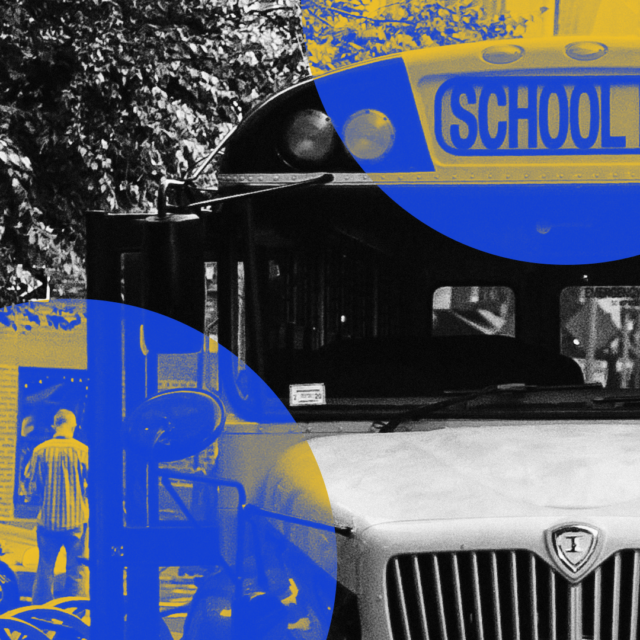Shooting Straight
What TV Stories Tell Us About Gun Safety, How These Depictions Affect Audiences, and How We Can Do Better
By: Soraya Giaccardi, M.S., Shawn Van Valkenburgh, Ph.D., Erica L. Rosenthal, Ph.D., Erica Watson-Currie, Ph.D.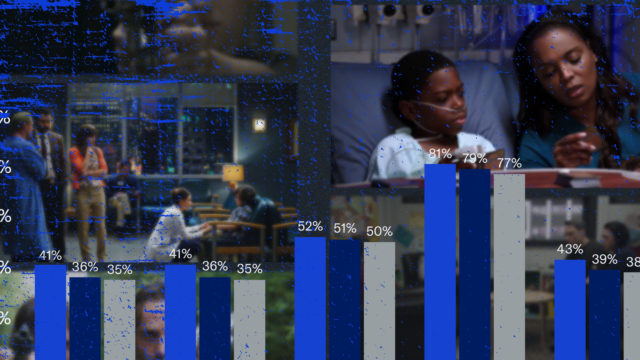
Executive Summary
On average, 110 people are killed by guns every day in the United States, with Black Americans disproportionately impacted. Young Black men are 20 times more likely to be killed by a gun than young white men, and between 2019 and 2020, deaths by guns increased by 39.5% among Black people. In 2021, for the first time, the director of the Centers for Disease Control and Prevention declared gun violence a “serious public threat.”
Firearms are the leading cause of death among children and teens, increasing by 29% from 2019 to 2020 alone. School shootings receive disproportionate media and policy attention and are a major source of fear, but 85% of child victims of gun homicide die in their homes, and over 80% of child gun suicides involve a gun owned by a family member. In addition, myths persist, such as the belief that gun violence is primarily caused by mental illness, or that a civilian “good guy” can intervene in an active shooting and save lives if they are allowed to carry a loaded gun.
Little is known about how often gun safety and prevention measures are portrayed or discussed or the impact of such portrayals on audiences.
The prevalence and impact of gun violence in entertainment media has been the subject of extensive research. Little is known, however, about how often gun safety and prevention measures are portrayed or discussed, in what contexts, or the impact of such portrayals on audiences. To address this gap, the USC Annenberg Norman Lear Center’s Media Impact Project (MIP) conducted a research project with support from Everytown for Gun Safety Support Fund. This included:
- A content analysis of popular, scripted television dramas from the 2019-2020 and 2020-2021 seasons.
- An experimental study examining the impact of two major gun safety storylines on audiences’ knowledge, beliefs, and policy support.
Content Analysis
We conducted two rounds of content analysis, examining 250 episodes of 33 unique TV series for depictions of gun safety practices and common myths about guns, discussions of gun laws, and characteristics of those holding firearms as well as shooting victims. The results were consistent across both seasons we analyzed:
- Guns were ubiquitous, with about six in 10 episodes including gun-related content. However, fewer than 10% of episodes with such content included depictions of secure gun storage or discussions related to gun laws or origins.
- Common myths about gun violence, such as perpetrators as mentally ill or the civilian “good guy with a gun” who intervenes in an active shooting, were also rare.
- Law enforcement officers were involved in the majority of TV firearm depictions. There was a common narrative portraying law enforcement officers as a diverse group of “good guys” fighting against nameless “bad guys.”
Experimental Study
We recruited 3,358 American adults, including parents and gun owners, and randomly assigned them to watch a clip from one of two gun safety-related storylines from Grey’s Anatomy and New Amsterdam, or a control storyline (unrelated to guns) from Chicago Med.
Viewing the Grey’s Anatomy storyline, which addressed an unintentional shooting in the home involving an improperly stored gun, led to:
- Greater knowledge of gun safety facts;
- Greater agreement that having a gun at home would make them feel less safe, but only among non-gun-owning respondents; and
- A stronger belief that storing guns and ammunition separately was important, but only if there were children in the hypothetical household.
Viewing the the New Amsterdam storyline, which focused on a student’s trauma following an active shooter drill with simulated violence, led to:
- Increased support for drills without simulated violence (e.g., online training, tabletop exercises, lockdown drills), finding such approaches more effective and less emotionally harmful than approaches with simulated violence or having armed law enforcement officers providing security in schools. These preferences were particularly pronounced among those who did not own guns themselves;
- Increased support for policies outlawing active shooter drills with simulated gun violence in schools, as well as those requiring parental consent before any type of shooter drill, screening students for trauma after drills, and broader preventative policies; and
- Reduced support for policies requiring public schools to participate in some sort of active shooter training.
Both gun storylines, and particularly Grey’s Anatomy, caused greater reactance — the feeling that someone is trying to manipulate you or threaten your freedom to choose — than the control clip.
- Gun owners experienced greater reactance to all three storylines.
- For each of the gun storylines, greater reactance was associated with greater likelihood of rejection of its gun safety messages, and less positive outcomes. Reactance suppressed, but did not eliminate, the positive effects of exposure to each of the gun storylines.
Both gun storylines, and particularly Grey’s Anatomy, caused greater reactance — the feeling that someone is trying to manipulate you or threaten your freedom to choose — than the control clip.
Conclusions and Recommendations
Based on these research findings, we propose the following recommendations for content creators and other storytellers to more accurately represent gun safety and prevention:
- Avoid portraying law enforcement use-of-force as heroic.
- Diversify depictions of those affected by gun violence.
- Include discussions of gun safety and common-sense gun laws.
- Appeal to common values.
Hear Highlights from Our Webinar
Introduction
Every day in the U.S., there are an estimated 110 gun-related deaths, totaling over 40,000 per year.1Everytown For Gun Safety Support Fund. (2021). The impact of active shooter drills in schools. https://everytownresearch.org/report/the-impact-of-active-shooter-drills-in-schools/#recommendations Black Americans are especially impacted by gun violence: firearm homicide rates among Black people increased by 39.5% from 2019 to 2020. Black men ages 15 to 34 were more than 20 times as likely to be killed with a gun than white men of the same age, and the number of Black women killed by guns also increased by 50% in the same time period.2Rabin, R. C., & Arango, T. (2022, May 10). Gun deaths surged during the pandemic’s first year, the C.D.C. reports. The New York Times. https://www.nytimes.com/2022/05/10/health/cdc-gun-violence-pandemic.html
The impacts of gun violence are not limited to adults. Approximately three million children and teens witness gun violence every year,3Finkelhor, D., Turner, H. A., Shattuck, A., & Hamby, S. L. (2015). Prevalence of childhood exposure to violence, crime, and abuse: Results from the national survey of children’s exposure to violence. JAMA Pediatrics 169(8), 764-754. https://doi.org/10.1001/jamapediatrics.2015.0676 and firearms are the leading cause of death for this group.4Everytown For Gun Safety. (n.d.). Child & teen gun safety. https://everytownresearch.org/issue/child-teen-safety/ In fact, firearm-related deaths among children and teens increased 29% from 2019 to 2020, with more than 4,300 U.S. children dying as a result of firearms in 2020 alone.5Goldstick, J. E., Cunningham, R. M., & Carter, P. M. (2022). Current causes of death in children and adolescents in the United States [Correspondence]. New England Journal of Medicine. https://doi.org/10.1056/NEJMc2201761 In 2021, for the first time ever, the director of the Centers for Disease Control and Prevention declared gun violence a “serious public threat.”6Cohen, B. & Bonifield, J. (2021, August 28). CNN Exclusive ‘Something has to be done’: After decades of near-silence from the CDC, the agency’s director is speaking up about gun violence. CNN Health. https://www.cnn.com/2021/08/27/health/cdc-gun-research-walensky/index.html
School Shootings
Eighty-five percent of child gun homicides occur inside the home, but these types of shootings are less likely to receive news coverage than school shootings. Since the Columbine High School shooting in 1999, shootings that take place in a school setting have been nearly four times as likely to receive coverage compared to other types of mass shootings.7Silva, J. R., & Capellan, J. A. (2019). A comparative analysis of media coverage of mass public shootings: Examining rampage, disgruntled employee, school, and lone-wolf terrorist shootings in the United States. Criminal Justice Policy Review, 30(9), 1312-1341. https://doi.org/10.1177/0887403418786556 Such coverage limits public understanding of the root of the problem — easy access to firearms and associated child gun injuries and deaths. As a result, much of the discourse around gun-safety has been restricted to in-school mitigation strategies.8Ropeik, D. (2018, March 8). School shootings are extraordinarily rare. Why is fear of them driving policy? The Washington Post. https://www.washingtonpost.com/outlook/school-shootings-are-extraordinarily-rare-why-is-fear-of-them-driving-policy/2018/03/08/f4ead9f2-2247-11e8-94da-ebf9d112159c_story.html
Efforts to prevent school shooting deaths often center on student and teacher preparation through active shooter drills. Ninety-five percent of American public K-12 schools have implemented active shooter drills and at least 40 states have mandated them.9Everytown For Gun Safety Support Fund. (2021). The impact of active shooter drills in schools. https://everytownresearch.org/report/the-impact-of-active-shooter-drills-in-schools/ However, there is no singular approach to active shooter drills and the term is generally used to describe a wide variety of strategies. Some drills, commonly referred to as “lockdown drills” ask students and teachers to practice hiding, barricading doors, and turning off lights. Other types of drills, sometimes referred to as “tactical drills,” might involve a law enforcement response or simulated gun violence. Some drills are announced ahead of time, while others are implemented without notice.10Rygg, L. (2015). School shooting simulations: At what point does preparation become more harmful than helpful. Child Legal Rights Journal, 35(3), 215-228. https://core.ac.uk/download/pdf/268432312.pdf Because policies around active shooter drills remain vague and no centralized system exists for tracking different types of active shooter drills, it is unclear just how many schools are implementing which types of drills.
In addition to inconsistency around the methods used in active shooter training, there is little evidence to suggest such training methods are effective at preventing mass shootings or minimizing their impact.11Everytown For Gun Safety Support Fund. (2021). The impact of active shooter drills in schools. https://everytownresearch.org/report/the-impact-of-active-shooter-drills-in-schools In fact, active shooter drills do little to prevent the circumstances that lead to school shootings, such as the ease of acquisition of firearms, and are therefore best described as strategies to mitigate the damage in a school shooting situation. Despite wide reliance on active shooter drills in schools, such drills have been associated with negative outcomes, such as depression, stress, and anxiety.12El Sherief, M., Saha, K., Gupta, P., Mishra, S., Seybolt, J., Xie, J., O’Toole, M., Burd-Sharps, S., & De Choudhury, M. (2021). Impacts of school shooter drills on the psychological well-being of American K-12 school communities: A social media study. Humanities and Social Sciences Communications, 8(1), 1-14. https://doi.org/10.1057/s41599-021-00993-6 In one survey of American youth, 60% reported that active shooter drills leave them feeling “scared and hopeless” and 21% reported feeling afraid to go to school.13Waselewski, M., Patterson, B. A., & Chang, T. (2020). Active shooter drills in the United States: A national study of youth experiences and perceptions. Journal of Adolescent Health, 67(4), 509-513.
Rather than relying exclusively on active shooter drills, Everytown for Gun Safety Support Fund (hereafter Everytown) recommends a number of tailored gun violence prevention policies and interventions.14Everytown For Gun Safety Support Fund. (2021). Keeping our schools safe: A plan for preventing mass shootings and ending all gun violence in American schools. https://everytownresearch.org/report/preventing-gun-violence-in-american-schools/#a-comprehensive-pln These include enacting, enforcing, and raising awareness about secure firearm storage laws and creating supportive school environments. Key features of effective school safety programs include ways to determine if a student has access to guns and access to professionals who can provide mental health services.
Shootings in the Home
While far less likely to receive media attention, youth gun deaths are much more likely to occur inside the home.15Everytown For Gun Safety Support Fund. (2021). Preventable tragedies: Findings from #NotAnAccident index. https://everytownresearch.org/report/notanaccident/ Eighty-five percent of children under 13 who are victims of gun homicide die in their home,16Fowler, K. A., Dahlberg, L. L., Haileyesus, T., Gutierrez, C., & Bacon, S. (2017). Childhood firearm injuries in the United States. Pediatrics, 140(1), e20163486. https://doi.org/10.1542/peds.2016-3486 and over 80% of child gun suicides involve a gun owned by a family member.17Johnson, R. M., Barber, C., Azrael, D., Clark, D. E., & Hemenway, D. (2010). Who are the owners of firearms used in adolescent suicides?. Suicide and Life-Threatening Behavior, 40(6), 609-611. https://doi.org/10.1521/suli.2010.40.6.609 From 2016 to 2020, 60% of child and teen deaths by firearm occured through homicide, 35% through suicide, and 4% were unintentional.18Everytown For Gun Safety Support Fund. (2021). The impact of gun violence on children and teens. https://everytownresearch.org/report/the-impact-of-gun-violence-on-children-and-teens/ An estimated 30 million children in the U.S. live in households with firearms, and 4.6 million live in a home with at least one loaded and unlocked gun.19Miller, M., & Azrael, D. (2022). Firearm storage in U.S. households with children: Findings from the 2021 National Firearm Survey. JAMA Network Open, 5(2), e2148823. https://doi.org/10.1001/jamanetworkopen.2021.48823
To protect children and teens from unintentional shootings in the home, Everytown recommends many of the same policy and programmatic solutions that are recommended for prevention of school shootings.20Everytown For Gun Safety Support Fund. (2021, August 30). Everytown releases new report detailing unintentional shootings by children and increase of children living with unsecured firearms [Press release]. https://everytownsupportfund.org/press/new-everytown-releases-new-report-detailing-unintentional-shootings-by-children-and-increase-of-children-living-with-unsecured-firearms/ These include statewide secure gun storage laws that require gun owners to unload, lock, and separate guns and ammunition, providing secure storage information to parents through schools, as well as the Gun Shop Project, which provides firearm retailers, instructors, and customers with firearm suicide prevention educational materials.
Gun Violence Myths and Reality
The myth that gun violence is caused by people with mental illness persists, despite evidence that those with mental health challenges are no more likely to commit gun-related crimes. A study by the National Center for Health Statistics indicated that only 3-5% of gun-related deaths in the U.S. are caused by people with a diagnosed mental illness.21Centers for Disease Control and Prevention. (2014). Leading causes of death reports. National and regional, 1999-2010. http://webappa.cdc.gov/sasweb/ncipc/leadcaus10_us.html In fact, people with mental illness are more likely to be victims of crime than the general population.22Hiday, V. A., Swartz, M. S., Swanson, J. W., Borum, R., & Wagner, H. R. (1999). Criminal victimization of persons with severe mental illness. Psychiatric Services, 50(1), 62-68. https://doi.org/10.1176/ps.50.1.62 The United States is not the only country with mental illness, domestic violence, or hate-fueled ideologies, but our gun homicide rate is 25 times higher than other high-income countries.23Grinshteyn, E., & Hemenway, D. (2019). Violent death rates in the US compared to those of the other high-income countries, 2015. Preventive Medicine, 123, 20-26. https://doi.org/10.1016/j.ypmed.2019.02.026 The difference is easy access to guns.
Another pervasive myth suggests that gun deaths can be prevented by the presence of a non-law enforcement “good guy with a gun” who saves lives due to their access to a firearm. This myth is commonly used to justify lenient concealed-carry legislation that allows people to carry loaded guns in public. However, a recent study found American states that allow concealed carry have higher rates of gun homicide than those that do not.24Fridel, E. E. (2021). Comparing the impact of household gun ownership and concealed carry legislation on the frequency of mass shootings and firearms homicide. Justice Quarterly, 38(5), 892-915. https://doi.org/10.1080/07418825.2020.1789693
The myth that gun violence is caused by people with mental illness persists, despite evidence that those with mental health challenges are no more likely to commit gun-related crimes.
Study Overview
Extensive research shows a high rate of gun violence in American entertainment media, which has been linked with aggressive thoughts, angry feelings, physiological arousal, and aggressive behaviors.25Bushman, B. J. (2016). Violent media and hostile appraisals: A meta-analytic review. Aggressive Behavior, 42(6), 605-613. https://doi.org/10.1002/ab.21655 Little is known, however, about how often gun safety and prevention strategies are portrayed, in what contexts, or the impact of such portrayals on different audiences. To address this gap, the USC Annenberg Norman Lear Center’s Media Impact Project (MIP) embarked on a research project with support from Everytown. This research included:
- Two rounds of content analysis tracking common myths about guns, depictions of gun safety practices, discussions of gun laws, and characteristics of both shooters and casualties in scripted television dramas from the 2019-2020 and 2020-2021 seasons.
- An experimental study examining the impact of two major gun safety storylines — from Grey’s Anatomy and New Amsterdam — on audiences’ knowledge, beliefs, and policy support related to guns in the home and prevention and mitigation of school shootings.
Content Analysis
Methodology
We conducted a systematic content analysis of two seasons of popular, scripted TV dramas (season 1: 2019-2020, season 2: 2020-2021), examining the following questions:
- How often are firearms shown on TV, and in what contexts?
- What kinds of characters are most likely to be shown holding or discharging firearms? Who is most likely to be shot on-screen?
- How often do TV shows portray gun storage or discuss the origins of firearms or gun laws? How often do they include dialogue about the role of guns in domestic violence or suicide?
- How often do TV shows perpetuate myths or stereotypes about gun violence, such as the idea that shooters are mentally ill, or the heroic “good guy with a gun”?
For each of the two seasons, we identified 25 popular, scripted drama series (see Appendix A for detailed content analysis methodology). Seventeen of these series were included in both seasons, for a total of 33 unique series. We randomly selected five episodes from each season of each series, giving a total of 250 episodes. We rigorously trained 16 USC student research assistants to code these episodes for the presence of gun-related content. We then compared findings across the two seasons (findings were largely consistent across both years). When the format “(X,Y)” is used in this report, the first number or percentage refers to season 1 (2019-2020), and the second refers to season 2 (2020-2021).
Guns Blazing
Guns were everywhere in popular scripted dramas, and particularly in shows focused on law enforcement.
- Around six in ten episodes (58%, 62%) included gun-related content. Of these, the majority (55%, 65%) were from police shows, which represented 36% of the sample.
- Season 1 had a total of 351 different gun-carrying characters (an average of 5 per episode), and season 2 had 406 (5.4 on average).
- Nearly one in three episodes (30%, 29%) portrayed at least one character discharging a firearm.
Guns were everywhere in popular scripted dramas.
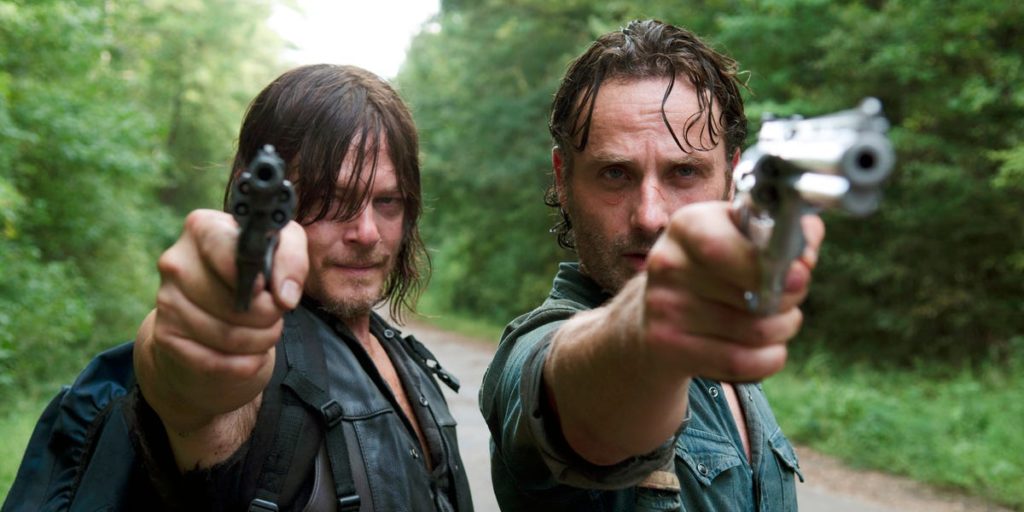
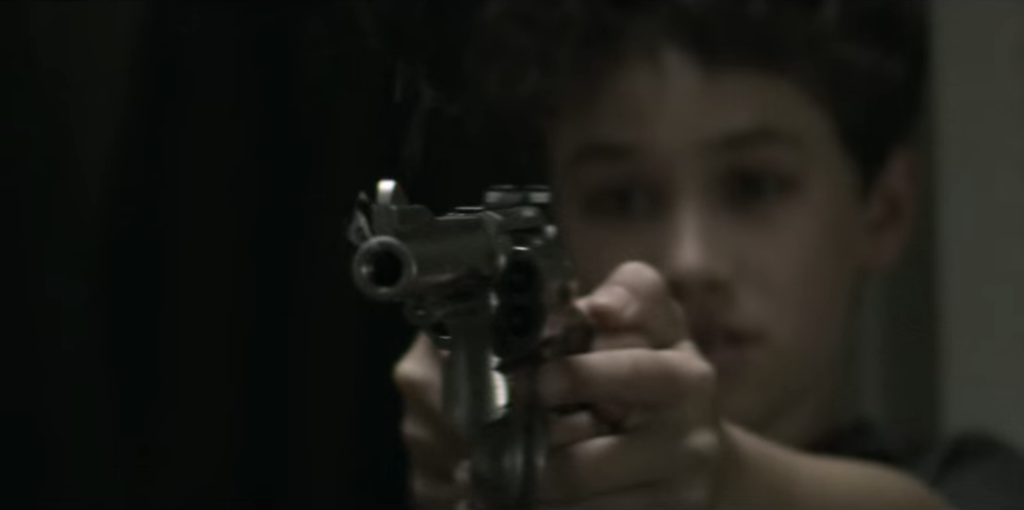
Cops and Robbers
Law enforcement officers were involved in the majority of TV firearm depictions. We identified a common narrative portraying law enforcement officers as “good guys” fighting against nameless “bad guys.” Compared to law enforcement, civilians with guns were more likely to be unsympathetic.
- Of those episodes that showed a gun being discharged, more than half (20%, 15%) included at least one shooting by a law enforcement officer.
- Most characters with guns were law enforcement (57%, 60%).
- The majority of law enforcement characters with guns had large roles (58%, 52%), compared to relatively few civilian characters (17%, 29%).
- More than nine in ten enforcement characters with guns were portrayed as sympathetic (93%, 91%), compared to few civilian characters (20%, 26%). Interrater reliability (agreement between coders) was borderline for this item, so the precise numbers should be interpreted with caution.
Civilian characters were more likely than law enforcement to fire their weapon or shoot someone.
- Civilians who held a gun were more than twice as likely to shoot someone (29%, 23%) as law enforcement officers (14%, 7%).
- Relatively few episodes (10%, 13%) featured gunfire or shootings that were just between civilian characters.
Figure 1. Percentage of gun-carrying characters who shot someone (N = 351, 406)
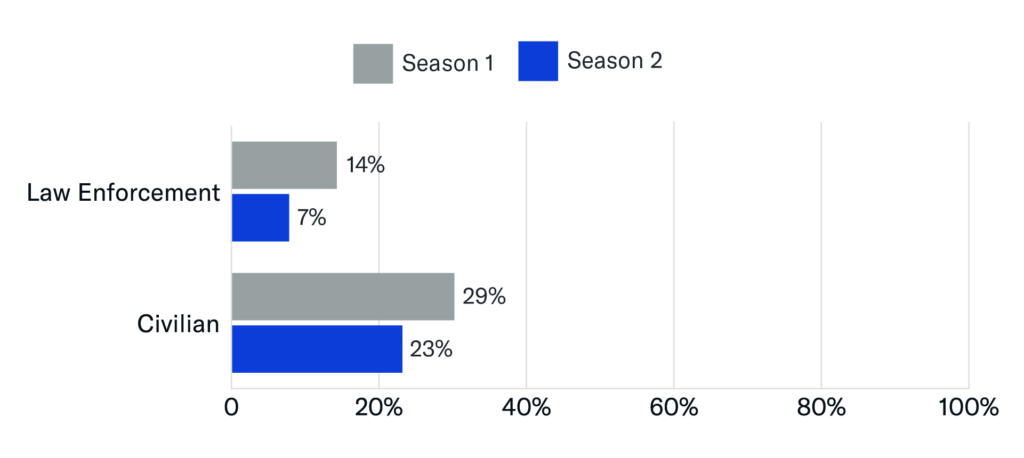
Shots Fired
Whereas those holding guns were largely depicted as “good guys,” those shot by guns were typically portrayed in the model of “bad guys.” More than half of casualties were unsympathetic white men with small roles.
- One in three episodes (36%, 32%) showed at least one person being shot.
- Fourteen percent of gun casualties were law enforcement officers.
- Most gun casualties were unsympathetic characters (52%, 57%) and had small roles (86%, 83%). About one third of those shot (38%, 36%) were armed themselves. Reliability was borderline for how sympathetic the character was.
- Most were male (77%, 87%) and white (54%, 63%).
Figure 2. Role size of casualties of gun violence (N = 106, 111)

Gun Storage
While guns were ubiquitous, depictions of secure gun storage, origins, laws, and impacts of domestic violence and suicide were rare. Because these things appeared infrequently, interrater reliability was low for these items. The precise numbers should be interpreted with caution, but we can be confident that they appeared rarely.
When gun storage did appear, a mix of secure and unsecure practices was depicted.
- Across both seasons, fewer than 10% of episodes with gun-related content showed secure gun storage.
- The Equalizer illustrated secure gun storage, such as when an FBI agent places a handgun in a safe that is locked with an electronic combination. In another episode, a former CIA agent unloads a handgun and places it in a concealed, fingerprint-activated gun safe.
- Unsecure storage was evident in an episode of FBI: Most Wanted, in which a teacher stores a handgun in a dresser drawer.
- Fewer than 10% of episodes with gun-related content featured unsafe practices such as impaired gun use, shooting a gun into the air, or unattended guns that are loaded.
Few episodes showed the origins of guns, but covered a variety of sources.
- Across both seasons, 14% of episodes with gun-related content showed or described the origins of a firearm. These included being taken from family members or friends, acquired from strangers, stolen from an employee, and other miscellaneous sources.
- For example, in an episode of NCIS, a character acquires ghost guns — “privately made firearms, shipped in pieces and assembled by the user” — and many disassembled ghost guns are shown loosely stored in an open cardboard box. In reality, ghost guns are increasingly recognized as a serious problem.26Everytown For Gun Safety Support Fund. (2020). Untraceable: The rising specter of ghost guns. https://everytownresearch.org/report/the-rising-specter-of-ghost-guns/
Episodes that included explicit discussion of gun safety, laws, domestic violence, or suicide were virtually nonexistent.
- Discussions of gun laws only appeared in two episodes, and were introduced in the context of characters charged with unauthorized possession and illegal sales of assault weapons.
- Season 2 of FBI: Most Wanted included an episode that referenced point-of-sale background checks, and an episode of Grey’s Anatomy vaguely referenced gun access as an abstract issue.
- Only one episode explicitly addressed gun violence in the context of domestic violence, and none in the context of suicide.
Myths and Stereotypes
While flawed narratives popularized by the gun lobby do exist on screen, they are fairly limited. We found scant stereotyping of gun violence perpetrators as mentally ill, and very few examples of a heroic “good guy with a gun.” These things appeared too rarely to capture reliability, so the precise numbers should be interpreted with caution.
- Of characters who held a gun, only five across both seasons faced mental health challenges, while five struggled with addiction.
- Only eight episodes across both seasons showed a non-law enforcement individual intervening in an active shooting.
Experimental Study
Methodology
Our content analysis research found that while guns are ever-present in scripted TV, depictions or discussions of gun safety and prevention measures remain exceedingly rare. When such storylines do exist, however, we sought to understand:
- What impact do they have on audiences’ knowledge, beliefs, and support for gun policies?
- How do they affect different audience segments, such as gun owners and parents?
- How do audiences respond to these storylines, and what role do these responses play in their ultimate impact?
To address these questions, we identified two major storylines from the previous five years addressing different aspects of gun safety and gun violence prevention:
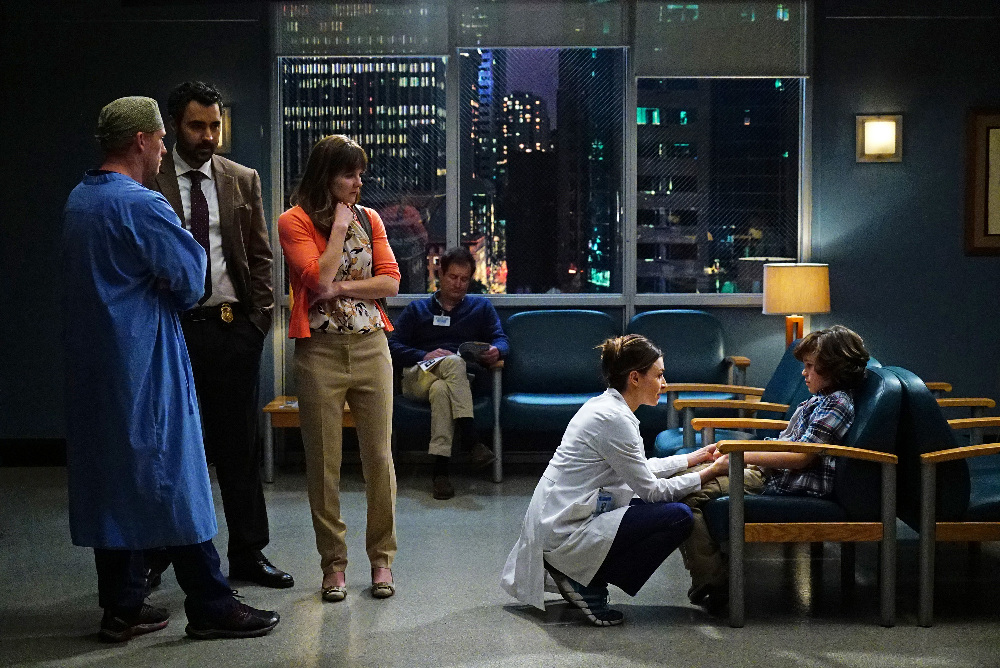
Grey’s Anatomy (ABC) — The episode “Trigger Happy” (2016) addresses the consequences of an unintentional shooting that occurs after a child accesses an improperly stored weapon at home.

New Amsterdam (NBC) — The episode “Perspectives” (2020) focuses on a child who is experiencing symptoms of trauma after participating in an active shooter drill with simulated gun violence at school.
We identified third storyline from a medical drama, involving a child but without any gun-related content, to serve as a control:
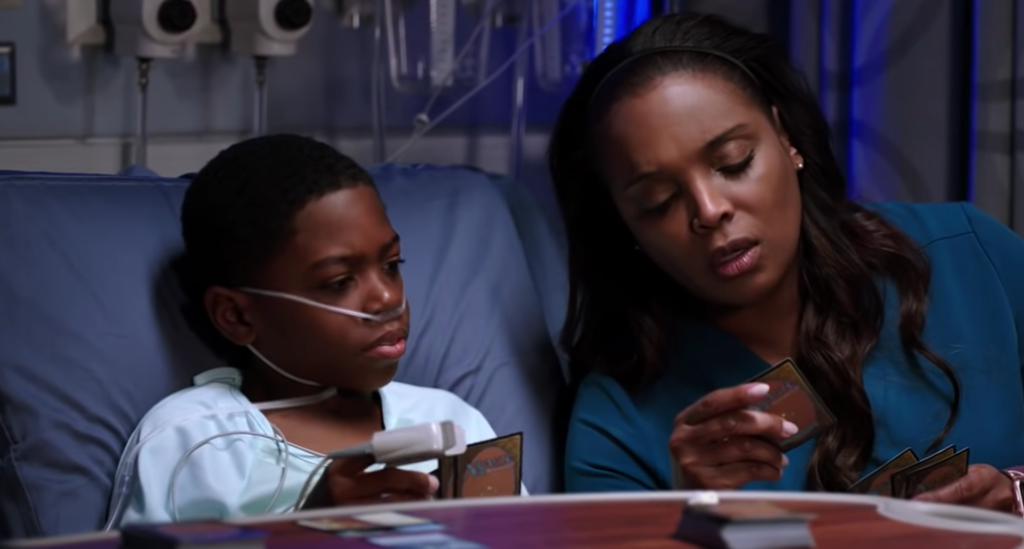
Chicago Med (NBC) — A multi-episode arc from the 2020-2021 season involves a foster child facing a medical emergency.
We recruited 3,358 Americans ages 18 and older from Qualtrics Panels to participate in an online survey in August 2021. We sought to recruit a sample approximately matched to U.S. Census data, but we also oversampled for gun owners. Thirty percent of American adults are gun owners, compared with 49% in our sample (defined as those with a firearm in their household, not including air guns, such as paintball, BB, or pellet guns).
Viewing Grey’s Anatomy led to greater agreement that having a gun at home would make them feel less safe, but only among those who were not already gun owners.
Participants were randomly assigned to view a 9-13 minute clip from one of the three storylines. Regardless of which storyline they were assigned, participants were asked about their knowledge and beliefs regarding gun safety in the home, beliefs about the effectiveness and emotional harm associated with active shooter training in schools, and support for related policies. We compared outcomes among those exposed to each of the gun-related storylines against the control group, and examined the underlying mechanisms of impact, such as psychological reactance to the story. Findings significant at a p < .05 level are reported here (see Appendix B for detailed experimental study methods).
Gun-Storage Storyline
We expected that viewing the gun-storage storyline on Grey’s Anatomy would lead to increased awareness of the importance of secure gun storage and more ambivalent feelings towards having a gun at home. Indeed, compared to the control clip, the Grey’s Anatomy storyline led to greater knowledge of gun safety facts. Still, only two out of five knowledge questions were answered correctly by the majority of participants in any condition:
- “Storing a gun properly can help prevent unintentional shootings, though not eliminate the risk.”
- “The majority of gun owners with children at home do not properly secure their guns.”
Figure 3. Percentage of participants who correctly answered “true” to each knowledge item
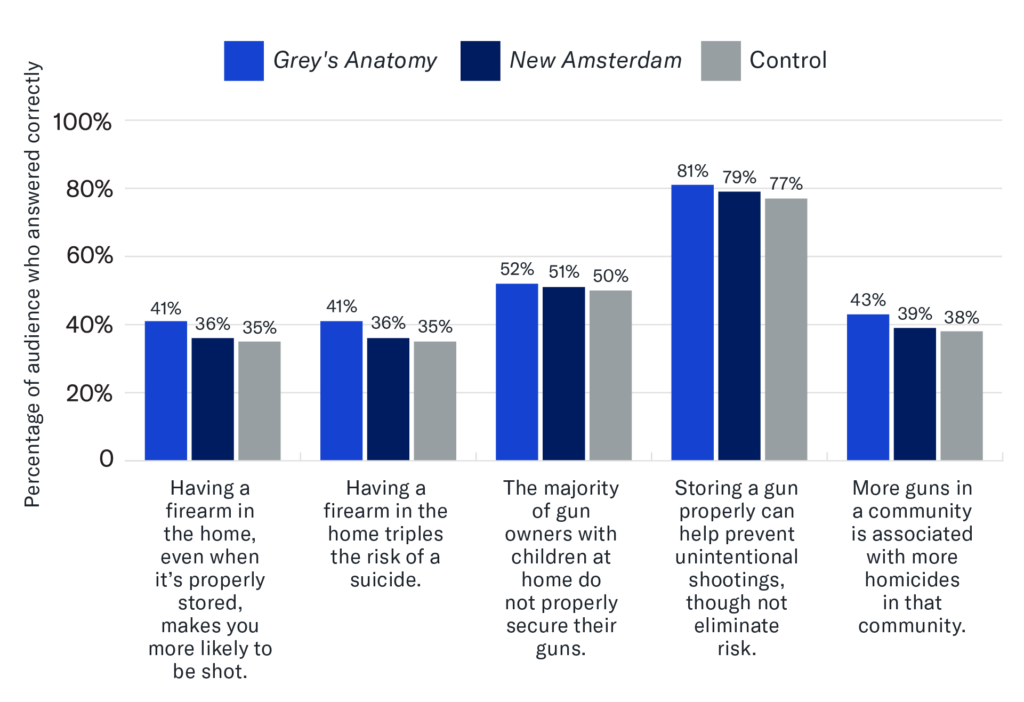
Viewing Grey’s Anatomy also led to greater agreement that having a gun at home would make them feel less safe, but only among those who were not already gun owners.
Figure 4. Perceived safety of having a gun in the home, by gun ownership
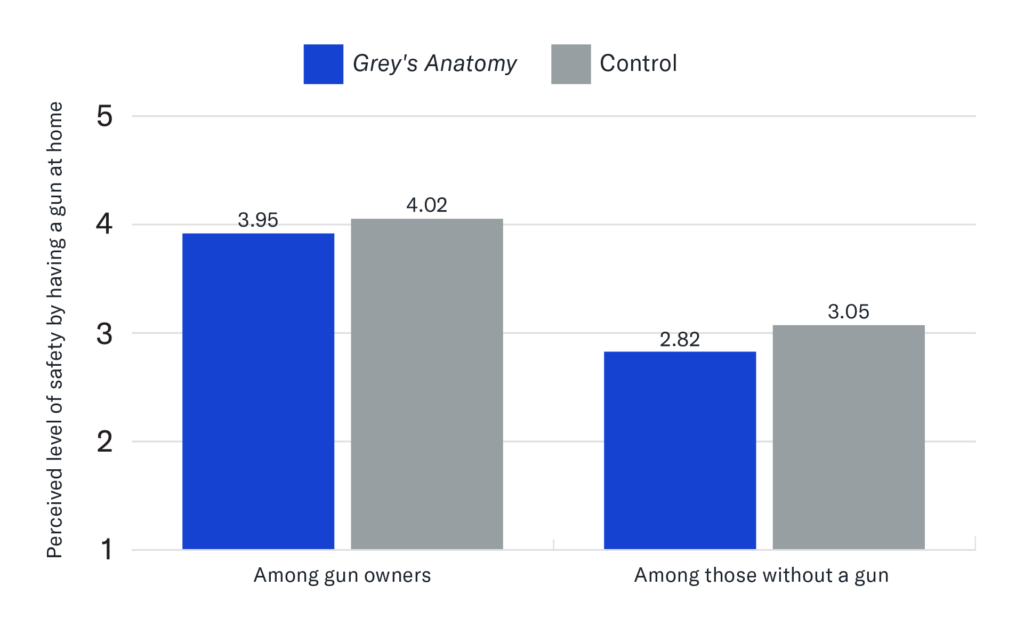
Finally, viewing the Grey’s Anatomy clip led to a stronger belief that storing guns and ammunition separately was important, but only if there were children in the hypothetical household.
Active Shooter Drill Storyline
We expected the active shooter drill storyline on New Amsterdam to lead to a preference for drills that do not include any simulated violence and greater support for policies regulating such drills. As expected, those assigned to watch New Amsterdam showed a preference for drills that do not include any type of simulated violence, compared to those who watched the control clip.
Viewing the New Amsterdam storyline led to the following training approaches being perceived as more effective:
- Tabletop exercises, which involve bringing together groups of students and teachers to talk through a hypothetical active shooter situation step-by-step without engaging in a simulation;
- Online/software based training.
Meanwhile, this storyline led to these approaches being perceived as less effective:
- Unannounced active shooter drills with simulated gun violence; where some or all individuals involved believe it is a real-life active shooter event;
- Employing law enforcement officers to provide armed security in schools.
Figure 5. Perceived effectiveness of different approaches to active shooter training
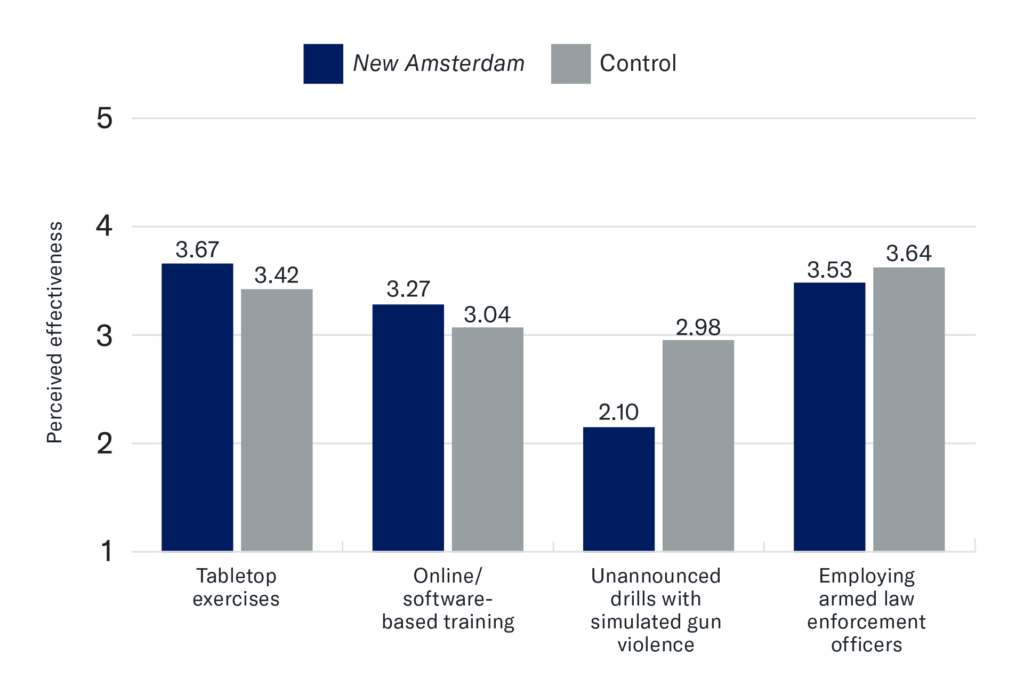
The New Amsterdam clip also led to a reduced belief that announced active shooter drills with simulated gun violence, where all individuals involved know that there is no real threat, are effective. This was especially true among those who were not gun owners.
Figure 6. Perceived effectiveness of announced active shooter drills with simulated violence, by gun ownership
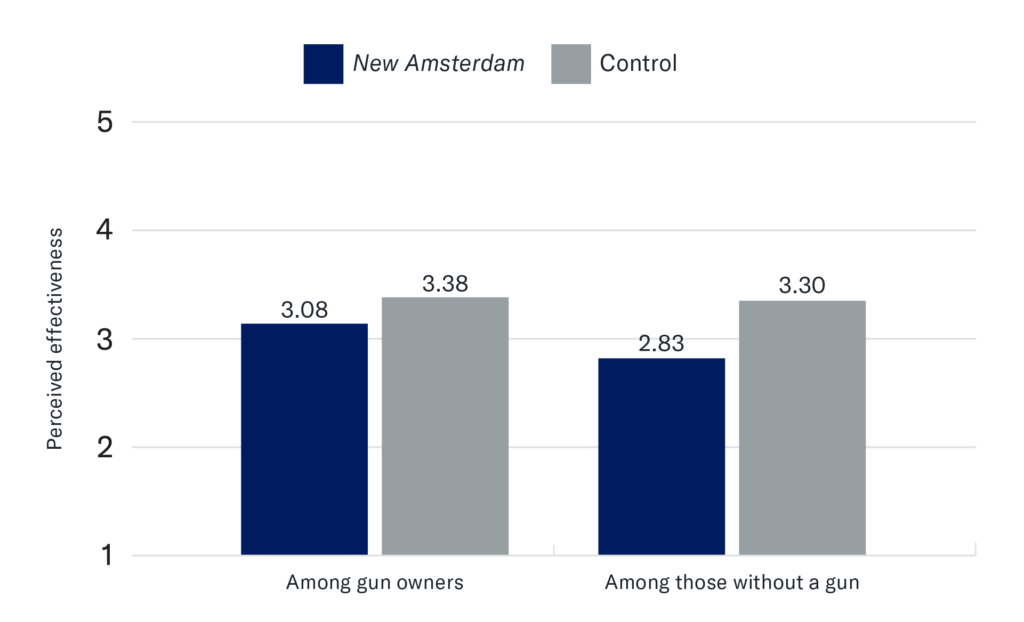
The New Amsterdam clip caused viewers to perceive both announced and unannounced drills with simulated violence as more emotionally harmful, and tabletop approaches as less harmful.
Figure 7. Perceived emotional harm caused by different training approaches
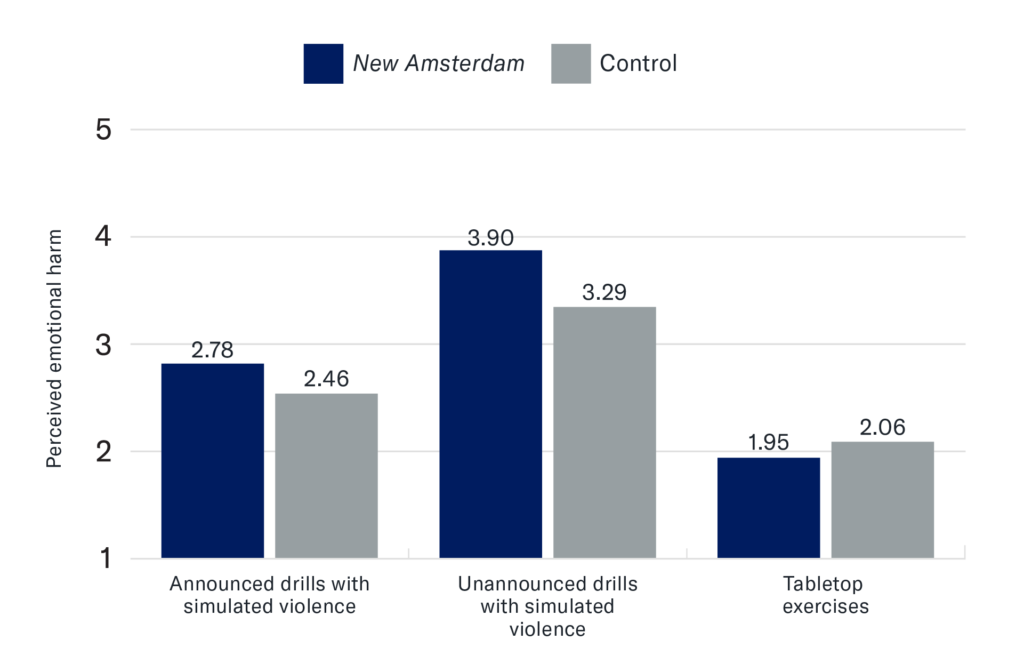
Compared to the control clip, the New Amsterdam storyline led to:
- Greater support for policies requiring parental consent before any type of shooter drill;
- Greater support for policies mandating that schools screen students for trauma after active shooter drills to provide counseling when needed;
- Lower support for policies requiring all public schools to participate in some sort of active shooter training;
- Greater support for policies mandating that schools have protocols and programs to prevent and intervene prior to a shooting, such as safe school design and promoting secure storage of firearms by parents.
Figure 8. Support for policies regulating active shooter training in schools
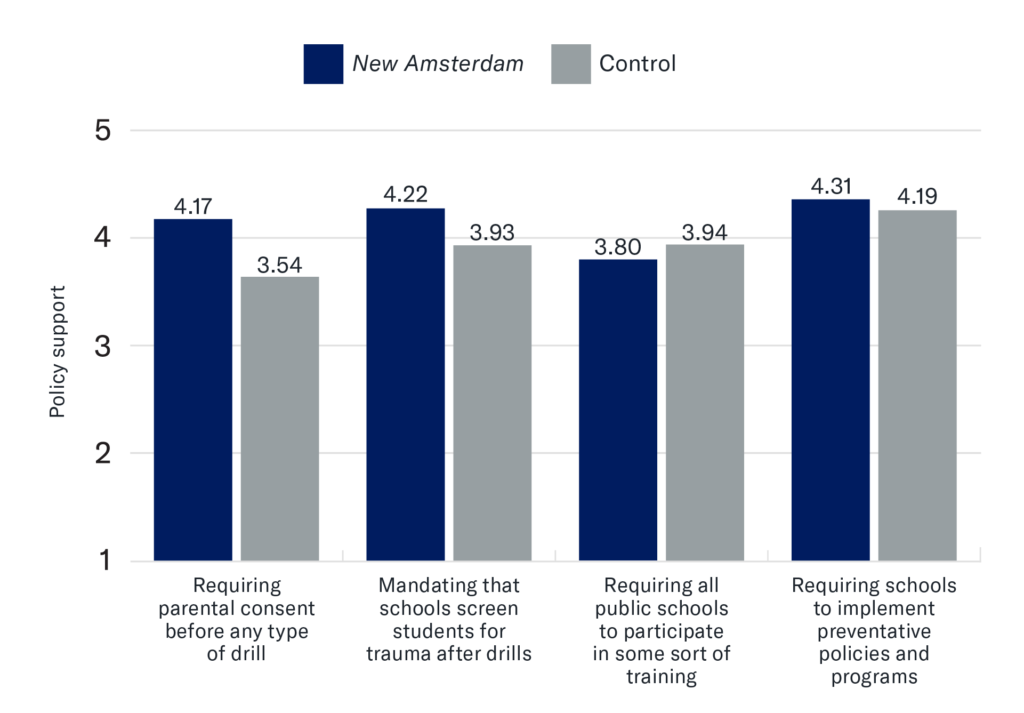
Viewing New Amsterdam led to increased support for policies outlawing any type of active shooter drill with simulated gun violence in public schools.
Finally, viewing New Amsterdam led to increased support for policies outlawing any type of active shooter drill with simulated gun violence in public schools. This was true of both gun owners and those who were not, but especially the latter group.
Figure 9. Support for policies outlawing active shooter drills with simulated gun violence, by gun ownership

Role of Reactance
Psychological reactance is the unpleasant feeling that someone or something is attempting to limit one’s choices or freedom.27Steindl, C., Jonas, E., Sittenthaler, S., Traut-Mattausch, E., & Greenberg, J. (2015). Understanding psychological reactance. Zeitschrift für Psychologie, 223(4), 205-2014. https://doi.org/10.1027/2151-2604/a000222 In the context of entertainment media, this generally means an audience member feels the content (or its creator) is trying to manipulate them or otherwise threatening their freedom to choose. Reactance is often associated with rejection of media messages.28Quick, B. L., Shen, L., & Dillard, J. P. (2013). Reactance theory and persuasion. In J. P. Dillard & L. Shen (Eds.), The SAGE handbook of persuasion: Developments in theory and practice (pp. 167-183). SAGE Publications.
Viewers of each of the three storylines generally experienced fairly low levels of psychological reactance.
- However, both gun storylines, and especially Grey’s Anatomy, caused more reactance than the control clip.
- Gun owners experienced greater reactance to all three storylines than those who were not gun owners.
Figure 10. Reactance to the storylines, by gun ownership
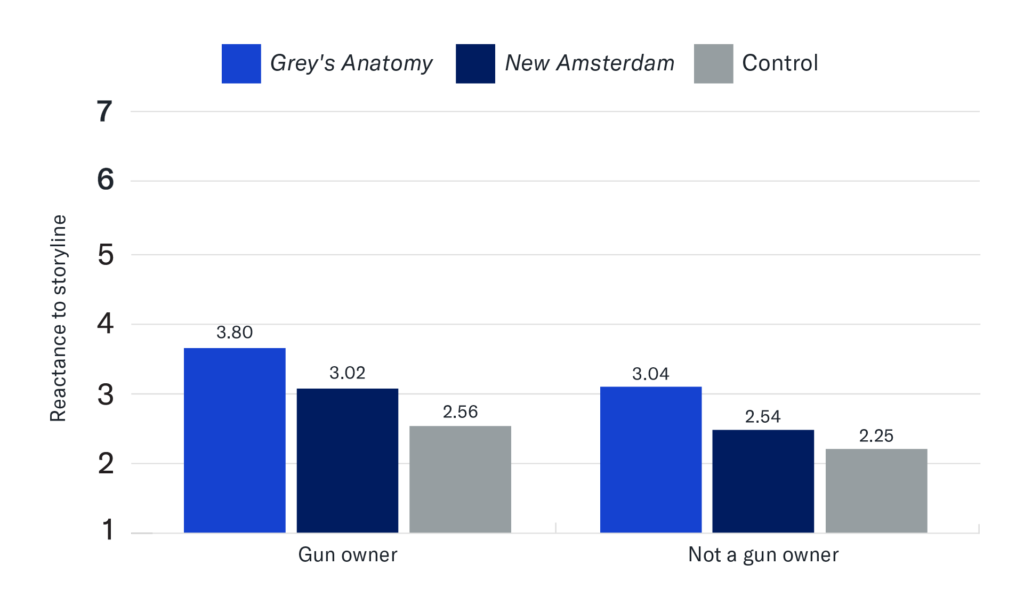
As expected, reactance to each storyline was associated with rejection of its gun safety messages.
Among Grey’s Anatomy viewers, those who experienced more reactance:
- Had lower knowledge of gun safety facts;
- Were less likely to believe storing guns and ammunition separately was important in households with children.
Among New Amsterdam viewers, those who experienced more reactance perceived:
- Tabletop exercises to be less effective and more harmful;
- Unannounced drills with simulated violence to be more effective and less harmful;
- Employing armed law enforcement in schools to be more effective.
New Amsterdam viewers who experienced greater reactance also had:
- Counterintuitively, greater support for policies outlawing drills with simulated violence;
- Reduced support for policies requiring parental consent, screening students for trauma, requiring schools to participate in some sort of training, and requiring schools to implement preventative policies and procedures.
Reactance to each storyline suppressed — but did not eliminate entirely — its positive impact on knowledge, attitudes, and policy support.
- Among those who watched the Grey’s Anatomy clip, reactance suppressed the positive impact on knowledge of gun safety facts and the importance of storing guns and ammunition separately.
- Among those who watched the New Amsterdam clip, reactance suppressed the positive impact on the perceived effectiveness and emotional harm of trauma-informed training methods and support for policies regulating the training methods used in schools.
Conclusion
The majority of episodes we examined from the 2019-2020 and 2020-2021 TV seasons included gun-related content. Some common myths and stereotypes — including depictions of shooters as mentally ill and the heroic civilian “good guy with a gun” — were all but nonexistent. However, portrayals of gun safety and gun-violence prevention also remain rare.
The majority of gun content appears in police shows in which law enforcement officers are the protagonists. Indeed, most of the characters with guns are police officers. Law enforcement officers are generally portrayed as sympathetic and at least partially justified in their use of lethal force. These findings are consistent with the Lear Center’s 2020 research in collaboration with Color of Change, which found that “good guy” law enforcement characters — often people of color — frequently act as implicit endorsers of a variety of wrongful police actions.29Color of Change Hollywood and The USC Annenberg Norman Lear Center. (2020). Normalizing injustice: The dangerous misrepresentations that define television’s scripted crime drama. https://hollywood.colorofchange.org/wp-content/uploads/2020/02/Normalizing-Injustice_Complete-Report-2.pdf This trope may give audiences the impression that any actions by law enforcement, up to and including shooting civilians, are inherently justifiable.
Depicting gun casualties as predominantly white masks and distorts the ways in which shootings by law enforcement disproportionately affect communities of color.
Whereas law enforcement officers with guns are depicted as diverse “good guys,” those who are shot on TV are typically nameless “bad guys,” who are — perhaps surprisingly — predominantly white. This inaccurate representation of gun casualties masks and distorts the ways in which shootings by law enforcement disproportionately affect communities of color. In reality, this violence is far from colorblind; Black Americans are three times more likely to be killed at the hands of law enforcement.30Everytown analysis of 2013 to 2019 Mapping Police Violence (accessed June 4, 2020) and population data from the US Census. This may underestimate the true rate as race was unknown for approximately 10% of the reported deaths. National Violent Death Reporting System 2009-2012 (17 states participating) and also shows Black Americans killed by police at a rate 2.8 times higher than white Americans, see DeGue et al., 2016. CDC’s data on 2010-2014 deaths categorized as legal intervention shows a rate of police killing of Black males aged 10+ 2.8 times higher than white males 10+ years old, see Buehler, 2017.
Although portrayals of gun safety and prevention are rare, when they do appear, they can have a substantial impact on viewers’ knowledge, attitudes, and support for what Everytown refers to as common-sense gun laws.31Everytown for Gun Safety. (n.d.). Solutions. https://www.everytown.org/solutions A storyline about a child shooting a playmate with an improperly stored gun led viewers to feel less safe with a firearm at home, and made them more likely to endorse the importance of storing guns and ammunition separately. A second storyline about children traumatized by an active shooter drill caused such tactics to be perceived as less effective and more emotionally harmful. This storyline also motivated increased support for policies regulating the use of these training techniques in schools, particularly those with any form of simulated violence.
The impact of the gun storylines was generally stronger among viewers who do not own guns. This was due in part to the reactance these storylines — particularly Grey’s Anatomy — evoked among gun owners. This is unfortunate, given how rare TV storylines about secure gun storage are, and the fact that guns in the home, not schools, pose the biggest threat to children. Ultimately, however, it is not surprising that the Grey’s storyline prompted reactance among gun owners; it explicitly discussed the dangers of having firearms in households with children and featured one doctor confronting another about their gun ownership. While reactance dulled the impact of both storylines, they were still persuasive. We did not find any differences in impact between parents and non-parents, though viewers of the Grey’s storyline believed greater caution is warranted if there are children in the hypothetical home.
Recommendations for Content Creators
The research described in this report highlights several strategies for content creators and other storytellers who wish to illuminate the realities of gun safety, gun-violence prevention, and use of force in the criminal justice system:
- Avoid portraying law enforcement use-of-force as heroic. Color of Change has advocated for — and had some success with — reducing the number of police shows on the air.32Color of Change. (2020, June 11). Color of Change wins campaign to get Live PD canceled on A&E. [Press release]. https://colorofchange.org/press_release/color-of-change-wins-campaign-to-get-live-pd-canceled-on-ae/ Beyond canceling police dramas, content creators can complicate the narrative around use-of-force by avoiding portraying such actions as heroic and unproblematic. Consider showing law enforcement characters facing consequences, or at least scrutiny for such actions, which are rarely depicted.33Color of Change Hollywood and The USC Annenberg Norman Lear Center. (2020). Normalizing injustice: The dangerous misrepresentations that define television’s scripted crime drama. https://hollywood.colorofchange.org/wp-content/uploads/2020/02/Normalizing-Injustice_Complete-Report-2.pdf
- Humanize and diversify depictions of those affected by gun violence. Nuanced depictions of shooting victims can make audiences care about gun violence as a public issue. These depictions can be broadened to include the effects on those who survive, as well as witnesses and the loved-ones of those lost. Consider that calling attention to the very real racial disparities in gun violence is a delicate balance. “Colorblind” depictions of victims may give audiences the impression that such disparities do not exist, but at the same time, constant media images of dead Black and brown men can be retraumatizing to members of these communities.
- Include discussions of gun safety and common-sense gun laws. Gun violence, including shootouts between cops and criminals, is overplayed on TV. Gun safety represents a largely untapped story opportunity. When told, these stories can change hearts and minds and even shift policy support. If they choose to depict or discuss a school shooting, content creators might consider explicitly drawing a connection to unsafe storage or gun laws in the show’s geographic setting.
- Appeal to common values. Heavy-handed stories can be alienating to gun owners who feel their freedoms are being threatened, or their beliefs mocked. Instead of making gun owners the antagonist, appeal to the common values shared by parents and others who care about keeping children safe.
Acknowledgements
The USC Norman Lear Center is led by Director Marty Kaplan and Managing Director Johanna Blakley. Special thanks to Veronica Jauriqui for project management and report formatting, and Emily Peterson for contributions to survey development.
Everytown for Gun Safety Support Fund team: Sophie Yan, Noelle Howey, Kate Reese, Tukio Machini, Casey Courtney, Sidney Namey, and Sandy Mui.
Propper Daley team: Dennis St. Rose and Emily Potashnick.
Content analysis coding by USC student research assistants: Sarah Chow, Charles Ding, Rebecca Ezersky, Alec Fisher, Roni Gayer, Sara Habeck, Charlie Hall, Alfonso Hegde, Ashley Jimenez, Marcus Johnson-Luther, Rachel Mamo, Alessandra Muir, Kelli Reitzfeld, Maya Rugama, Kelsey Towfiq, and Alisa Wu.
All images used in the report are the sole property of the networks the series belong to. The still photos are used under educational fair use guidelines, for the explicit purpose of supporting this research report.
Learn More
Authors
-
Soraya Giaccardi, M.S.
Senior Researcher at USC Annenberg Norman Lear Center
-
Shawn Van Valkenburgh, Ph.D.
Project Associate at USC Annenberg Norman Lear Center
-
Erica L. Rosenthal, Ph.D.
Director of Research at USC Annenberg Norman Lear Center
-
Erica Watson-Currie, Ph.D.
Research Associate at USC Annenberg Norman Lear Center
In partnership with
-
![USC Annenberg Norman Lear Center Media Impact Project logo]()
USC Annenberg Norman Lear Center’s Media Impact Project
The Media Impact Project is a hub for collecting, developing and sharing approaches for measuring the impact of media, aiming to better understand the role that media plays in changing knowledge, attitudes and behavior among individuals and communities.



